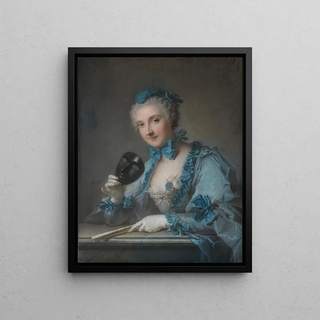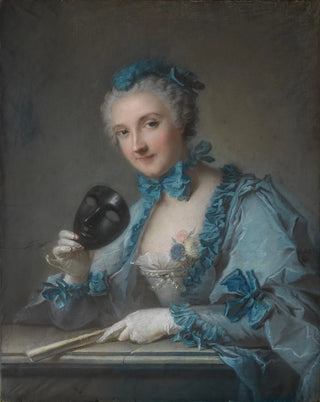Art print | Portrait of Louise Geneviève Royer - Jean-Marc Nattier


View from behind

Frame (optional)
Portrait of Louise Geneviève Royer - Jean-Marc Nattier – Captivating Introduction
The "Portrait of Louise Geneviève Royer," created by Jean-Marc Nattier, is an iconic work of the 18th century, showcasing the refinement and elegance of the era. This portrait, which captures the beauty and grace of its subject, offers a fascinating glimpse into French society of its time. Louise Geneviève Royer, presented with striking delicacy, embodies the ideals of beauty and virtue that prevailed in aristocratic circles. The subtle composition and delicate colors of this painting invite attentive contemplation, revealing the nuances of human emotion through the lens of art.
Style and uniqueness of the work
Nattier, master of the portrait, stands out for his ability to blend realism and idealization. In this piece, he manages to capture not only the physical appearance of Louise Geneviève Royer but also her inner essence. The choice of colors, ranging from soft hues to luminous highlights, creates an atmosphere that is both intimate and majestic. The drapery of the clothing, carefully crafted, seems almost alive, while the gaze of the young woman, both serene and penetrating, engages the viewer in an emotional connection. This style, characteristic of Nattier's art, demonstrates impressive technical mastery and rare artistic sensitivity, making this art print a unique piece that transcends time.
The artist and his influence
Jean-Marc Nattier, born in 1685, is one of the most renowned portrait artists of his time, having established himself at the court of Louis XV. His career is marked by an unceasing quest for beauty and harmony, values that resonate deeply in his works. Nattier was influenced by the great masters of the past, but he developed a distinctive style, combining fine detail with a freer, more expressive approach. His portraits, often commissioned by the aristocracy, reflect an era when personal image was synonymous with social status. Nattier's impact on portrait art is undeniable, inspiring many artists who followed him and contributing to

Matte finish

View from behind

Frame (optional)
Portrait of Louise Geneviève Royer - Jean-Marc Nattier – Captivating Introduction
The "Portrait of Louise Geneviève Royer," created by Jean-Marc Nattier, is an iconic work of the 18th century, showcasing the refinement and elegance of the era. This portrait, which captures the beauty and grace of its subject, offers a fascinating glimpse into French society of its time. Louise Geneviève Royer, presented with striking delicacy, embodies the ideals of beauty and virtue that prevailed in aristocratic circles. The subtle composition and delicate colors of this painting invite attentive contemplation, revealing the nuances of human emotion through the lens of art.
Style and uniqueness of the work
Nattier, master of the portrait, stands out for his ability to blend realism and idealization. In this piece, he manages to capture not only the physical appearance of Louise Geneviève Royer but also her inner essence. The choice of colors, ranging from soft hues to luminous highlights, creates an atmosphere that is both intimate and majestic. The drapery of the clothing, carefully crafted, seems almost alive, while the gaze of the young woman, both serene and penetrating, engages the viewer in an emotional connection. This style, characteristic of Nattier's art, demonstrates impressive technical mastery and rare artistic sensitivity, making this art print a unique piece that transcends time.
The artist and his influence
Jean-Marc Nattier, born in 1685, is one of the most renowned portrait artists of his time, having established himself at the court of Louis XV. His career is marked by an unceasing quest for beauty and harmony, values that resonate deeply in his works. Nattier was influenced by the great masters of the past, but he developed a distinctive style, combining fine detail with a freer, more expressive approach. His portraits, often commissioned by the aristocracy, reflect an era when personal image was synonymous with social status. Nattier's impact on portrait art is undeniable, inspiring many artists who followed him and contributing to






